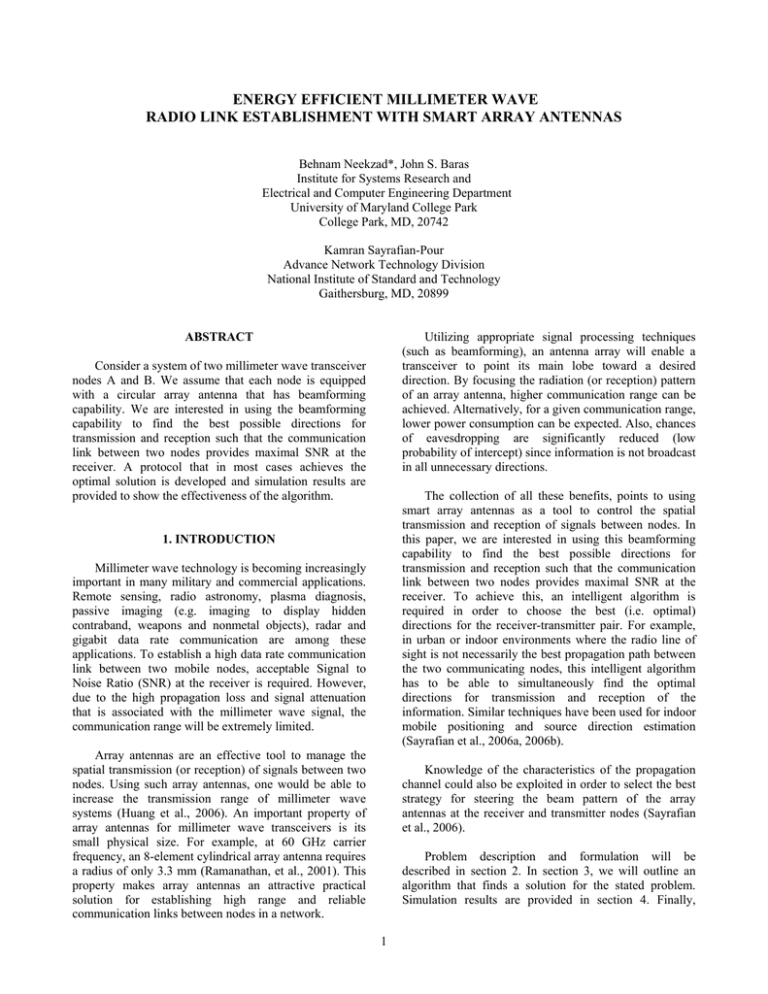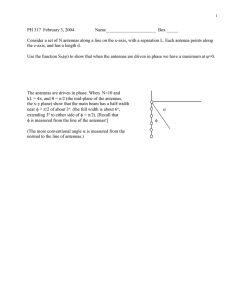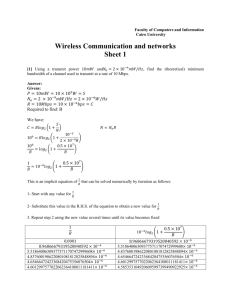ENERGY EFFICIENT MILLIMETER WAVE RADIO LINK ESTABLISHMENT WITH SMART ARRAY ANTENNAS
advertisement

ENERGY EFFICIENT MILLIMETER WAVE RADIO LINK ESTABLISHMENT WITH SMART ARRAY ANTENNAS Behnam Neekzad*, John S. Baras Institute for Systems Research and Electrical and Computer Engineering Department University of Maryland College Park College Park, MD, 20742 Kamran Sayrafian-Pour Advance Network Technology Division National Institute of Standard and Technology Gaithersburg, MD, 20899 Utilizing appropriate signal processing techniques (such as beamforming), an antenna array will enable a transceiver to point its main lobe toward a desired direction. By focusing the radiation (or reception) pattern of an array antenna, higher communication range can be achieved. Alternatively, for a given communication range, lower power consumption can be expected. Also, chances of eavesdropping are significantly reduced (low probability of intercept) since information is not broadcast in all unnecessary directions. ABSTRACT Consider a system of two millimeter wave transceiver nodes A and B. We assume that each node is equipped with a circular array antenna that has beamforming capability. We are interested in using the beamforming capability to find the best possible directions for transmission and reception such that the communication link between two nodes provides maximal SNR at the receiver. A protocol that in most cases achieves the optimal solution is developed and simulation results are provided to show the effectiveness of the algorithm. The collection of all these benefits, points to using smart array antennas as a tool to control the spatial transmission and reception of signals between nodes. In this paper, we are interested in using this beamforming capability to find the best possible directions for transmission and reception such that the communication link between two nodes provides maximal SNR at the receiver. To achieve this, an intelligent algorithm is required in order to choose the best (i.e. optimal) directions for the receiver-transmitter pair. For example, in urban or indoor environments where the radio line of sight is not necessarily the best propagation path between the two communicating nodes, this intelligent algorithm has to be able to simultaneously find the optimal directions for transmission and reception of the information. Similar techniques have been used for indoor mobile positioning and source direction estimation (Sayrafian et al., 2006a, 2006b). 1. INTRODUCTION Millimeter wave technology is becoming increasingly important in many military and commercial applications. Remote sensing, radio astronomy, plasma diagnosis, passive imaging (e.g. imaging to display hidden contraband, weapons and nonmetal objects), radar and gigabit data rate communication are among these applications. To establish a high data rate communication link between two mobile nodes, acceptable Signal to Noise Ratio (SNR) at the receiver is required. However, due to the high propagation loss and signal attenuation that is associated with the millimeter wave signal, the communication range will be extremely limited. Array antennas are an effective tool to manage the spatial transmission (or reception) of signals between two nodes. Using such array antennas, one would be able to increase the transmission range of millimeter wave systems (Huang et al., 2006). An important property of array antennas for millimeter wave transceivers is its small physical size. For example, at 60 GHz carrier frequency, an 8-element cylindrical array antenna requires a radius of only 3.3 mm (Ramanathan, et al., 2001). This property makes array antennas an attractive practical solution for establishing high range and reliable communication links between nodes in a network. Knowledge of the characteristics of the propagation channel could also be exploited in order to select the best strategy for steering the beam pattern of the array antennas at the receiver and transmitter nodes (Sayrafian et al., 2006). Problem description and formulation will be described in section 2. In section 3, we will outline an algorithm that finds a solution for the stated problem. Simulation results are provided in section 4. Finally, 1 conclusions and future work will be discussed in Section 5. (α * , β * ) = Arg max α , β R(α , β ) 2 A simple method to find the solution of this problem is to conduct an exhaustive search over the space of all possible (α , β ) . However, depending on the resolution of this space, this methodology might not be feasible for practical purposes. In this paper, we propose a two step approach to find a sub-optimal value for the pair (α , β ) . In the next sections, we will outline our approach and investigate its performance with simulations for different scenarios. 2. PROBLEM DESCRIPTION AND FORMULATION Consider a system of two transceiver nodes A and B. We assume that each node is equipped with a circular array antenna that has beamforming capability. In other words, it is able to electronically steer its main lobe in the two-dimensional space (i.e. azimuth) toward any desired direction (see Fig. 1). In addition, assume that each antenna is also capable of generating an omni-directional gain pattern as well. 3. POROTOCOL DESCRIPTION The Received Signal Strength (RSS) is clearly a function of the directions where the main lobes of both antennas are pointing at. The directions that maximize the RSS are functions of both antenna patterns and the channel response (i.e. the environment). For environments with severe multipath propagation, it is important to locate these optimal directions in order to maximize the signal to noise ratio at the receiver. This is especially interesting in scenarios where the line of sight path has been blocked by an object with large attenuation. Step 1: Node A is in the transmit mode with an omnidirectional gain pattern. This means that ideally, the transmitter’s antenna gain for all azimuth angels is c where c is a constant. At the same time, node B is in the receive mode with beamforming capability. Initially, the main lobe of the receiver’s antenna pattern is pointing toward a starting angle e.g. β 0 . Now, the beamformer rotates the main lobe around the 360 degrees field of view with a step size of ∆ B . (i.e. β j = β 0 + j∆ B ). At each α step, the receiver calculates the received signal strength and finds the direction β j where the RSS is maximal. If Main lobe β j * denotes Side lobe this angle, mathematically this step can be expressed by the following equations. R( β j ) = 2π C ∫ ∫ x(θ ) h(θ , φ ) y (φ , β j ) dθ dφ Fig 1: Beam steering in array antennas φ θ β j = Arg max β R( β j ) * Assume that x(θ ,α ) denotes the transmitter’s antenna gain at angle θ when the main lobe is pointing at direction α . Similarly, y (φ , β ) denotes the receiver’s antenna gain at angle φ 2 j Step 2: Now that β j * has been obtained, node B goes into transmit mode and notifies node A that it has found its desired direction. Then, node A turns into a receiver with beamforming capability and the main lobe toward the starting angle α 0 . Next, the beamformer at when the main lobe is pointing at direction β . If h(θ , φ ) is the angular channel response for a path that starts from angle θ of the transmitter’s antenna and ends at angle φ of the receiver’s antenna, then the received signal R can be expressed by: node A rotates the main lobe around the 360 degrees field of view with a step size of ∆ A (i.e. α i = α 0 + i∆ A ). At R (α , β ) = ∫∫ x(θ , α ) h(θ , φ ) y (φ , β ) dθ dφ each step, the receiver at node A calculates the received signal strength and finds the direction α i where the RSS θ ,φ is If α i * denotes this angle, then mathematically this step can be expressed by the following equations. Here, for simplicity, we are also assuming that the propagation process is stationary. Our objective in this paper is to find the optimal directions (α , β ) that maximize the received power as defined below: * maximal. * 2 R (α i ) = ∫∫ x(θ , α i ) h′(θ , φ ) y (φ , β j * )dθ dφ θ ,φ α i * = Arg max α R (α i ) α 2 β i Side lobe If the beamwidths of the main lobes created by the array antennas at Nodes A and B are γ A and γ B respectively, then the rotation step size in the above protocol should obey the following equations Main lobe B A ∆A ≤ γ A ∆B ≤ γ B Fig. 2: Simulation layout The beamwidths γ A and γ B depend on the size (i.e. number of elements) of the array antennas at the Nodes A and B. The choices for ∆ A and ∆ B clearly affect the speed with which the algorithm runs. Therefore, other hardware implementation issues might need to be taken into account. Having such an antenna with beamforming capability enables each node to steer the direction of its main beam toward any desired angle (i.e. 360-degree field of view). Sample beam patterns of such an antenna for various array sizes (i.e. number of elements) are shown in Fig. 3. In the next section, we provide simulations of this algorithm and show the effectiveness of the results. 4- SIMULATION RESULTS (a) To investigate the effectiveness of the proposed algorithm, a simulation platform was implemented. The main difficulty in simulating a wireless channel is the strong dependence of the received signal on the surrounding environment (e.g. multipath channel). In particular, all obstacles such as walls, that affect the propagation of RF waves, will directly impact the signal strength and more importantly the directions from which RF signal energy is received. Empirical, statistical and deterministic models have been used to describe the behavior of such multipath channels (Hashemi 1993; Spencer et al., 2000; Ertel et al., 1998). In this study, we have elected to use a sophisticated ray-tracing tool to accurately predict the received signal strength in a multipath RF channel. Wireless System Engineering (WiSE) is a ray-tracing tool that has been developed and verified by Bell Laboratories (Fortune et al., 1995; Valenzuela et al., 1997). We realize that even such models have limitations in their accuracy and are also subject to errors when there are changes in the environment, however, this approach will give us the opportunity to simulate the performance of the proposed protocol in a multipath channel and at the same time provide a geometric interpretation of the results. (b) Fig. 3: Beam pattern of a circular array with (a) 8 elements (b) 32 elements In general, the strength of the received signal heavily depends on the environment layout, dielectric properties of the surrounding material, transmitter-receiver locations, operating frequency and array sizes of the receiver and transmitter antennas. For the example given in Fig. 2, the received power is a function of the azimuth angles of the main lobes of both transmitter and receiver. Fig. 4 displays this received power as a result of simulation with a pair of 32 element circular array antennas at the receiver-transmitter pair and a transmission frequency of 60GHz. We first consider a very simple layout and two transceiver nodes (A and B) as shown in Fig. 2. It is assumed that each node is equipped with a circular array antenna of a given size. 3 The effectiveness of the link establishment algorithm was also investigated in a variety of other scenarios and some examples demonstrating the final direction, chosen for the main lobes of the antenna’s beam pattern, are shown in Fig. 8. These include single-reflected and double reflected paths as they created the highest signal strength at the receiver. Fig. 4: Normalized RSS as a function of the direction of the transmitter/receiver’s main lobes A As observed, 12 different locations on this plot (i.e. pairs of ( α , β ) ) exhibit received signal strength that are relatively stronger than other directions. These peaks correspond to the situations where the main lobes of the transmitter-receiver pair are positioned in a way to capture the line of sight, single-reflected and doublereflected signals respectively. Existence of a clear LOS path in this example signifies the strong RSS component that is visible at α = 90D and β = 270D . The link establishment algorithm proposed in the previous section achieves these optimal directions (i.e. α = 90D and β = 270D ) as symbolically shown in Fig. 5. A Fig. 6: α, β B selected by the link establishment algorithm B Fig. 7: RSS as a function of the direction of the transmitter/receiver main lobes Fig. 5: α, β The direction pair displayed in this figure is also the optimal directions that could have been selected by exhaustive search of all possible directions. selected by the link establishment algorithm 5- CONCLUSIONS AND FUTURE WORK If this LOS path did not exist, for example due to an obstacle that blocks this path, then one of the propagation paths that contains a single-reflected signal will yield the best signal strength for the receiver. We also simulated this situation and Fig. 6 shows the resulting link that our proposed algorithm has chosen. The underlying philosophy in this paper is that exploiting the information in the spatial distribution of RF energy around both transmitter and receiver results in better quality communication links. The proposed protocol outlines a methodology to obtain the directions where the beam steering algorithms at the receiver and transmitter should use. These are indeed the optimal directions for the main lobes of the transmitter and receiver nodes as the simulation shows that the highest value of the RSS occurs at α = 40D These directions achieve higher signal strength at the receiver; and therefore, a more reliable link can be expected. Although, all our simulations have shown that the selected directions are optimal, it is still conceivable that special scenarios could exist where the optimal and β = 320D (see Fig. 7). 4 fact that the large bandwidth available at millimeter wave frequencies results in very high data transmission rate; also helps to minimize the amount of time that a node needs to stay in transmission mode; and therefore, minimizes the possibility of its transmission being detected. directions are not achieved by the proposed algorithm. However, in order to capitalize on the capability of such antenna arrays, it is important to have an algorithm that can quickly converge to optimal (or near optimal) directions. The speed of this convergence is even more important when one or both of the communicating nodes are mobile. An adaptive version of the proposed algorithm will be an attractive solution for applications that involve mobile nodes. In this paper, we have only considered scenarios involving two nodes. In the future, we would like to investigate the extension of the algorithm when multiple nodes, equipped with multi-beam array antennas, are communicating. Further studies and more importantly experimental data are required to assess the performance of the link establishment algorithm in practice. Node B REFERENCES R. B. Ertel, P. Cardieri, K. W. Sowerby, T. S. Rappaport, J. H. Reed, “Overview of spatial channel models for antenna array communication systems”, IEEE Personal Communications, Vol. 5, Issue: 1, Pages: 10 – 22, Feb. 1998. Node A S. J. Fortune, D. M. Gay, B. W. Kernighan, O. Landron, R. A. Valenzuela, M. H. Wright, “WISE design of indoor wireless systems: practical computation and optimization”, IEEE Computational Science and Engineering, Vol. 2, Issue: 1, Pages: 58 – 68, Spring 1995. (a) Node A H. Hashemi, “The Indoor Radio Propagation Channel”, Proceedings of the IEEE, Vol. 81, No. 7, July 1993. Node B K. Huang, Z. Wang “Millimeter-Wave Circular Polarized Beam-Steering Antenna Array for Gigabit Wireless Communications” IEEE Trans. on Antennas and Propagation, Vol. 54, Feb 2006. (b) J. C. Liberti and T. S. Rappaport, Smart Antennas for Wireless Communications, Prentice Hall, 1999. Fig. 8: Optimal directions of the transmitter/receiver main lobes (a) Single reflected path (b) Double reflected path R. Ramanathan, “On the Performance of Ad Hoc Networks with Beamforming Antennas”, in Proceedings of ACM MOBIHOC, 2001. Once the link is established, a power control mechanism can be implemented to reduce transmission power in order to conserve energy and prolong battery lifetime for mobile nodes. Minimizing the necessary transmission power also contributes to lowering the interference on spectrally co-existing systems. Therefore, multiple nodes can have simultaneous communication without affecting the reliability of each other’s link. K. Sayrafian, B. Neekzad, J. Perez, J. Baras, “RayTracing Simulation of the NICT Channel Measurements”, IEEE Standard 802.15.3c mm-Wave channel modeling subgroup doc. # IEEE 802.15-060326-00-003c, July 2006. K. Sayrafian, D. Kaspar, “Source-Assisted Direction Estimation Inside Buildings”, Proceedings of IEEE INFOCOM’06, April 23-29, 2006a, Barcelona, Spain. Finally, in many military and defense-related applications, where low probability of intercept is of paramount importance, avoiding wireless transmission in all directions significantly reduces the chance of the RF signal to be detected by the enemy. This along with the 5 K. Sayrafian-Pour, D. Kspar, “Application of Beamforming in Wireless Location Estimation”, EURASIP Journal on Applied Signal Processing, Volume 2006 (2006b), Article ID 51673. Q. H. Spencer, B. D. Jeffs, M. A. Jensen, A. L. Swindlehurst, “Modeling the statistical time and angle of arrival characteristics of an indoor multipath channel”, IEEE Journal on Selected Areas in Communications, Vol. 18, Issue: 3, Pages: 347 – 360, March 2000. R. A. Valenzuela, O. Landron, D. L. Jacobs, “EstimatingLocal Mean Signal Strength of Indoor Multipath Propagation”, IEEE Transactions on Vehicular Technology, Vol. 46, No.1, Feb. 1997 6



